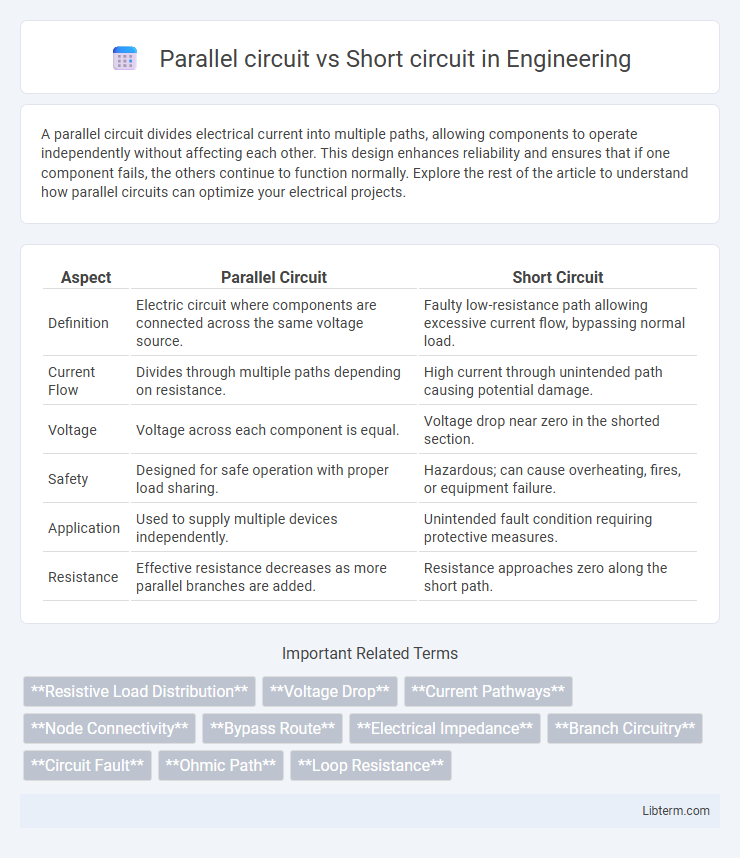A parallel circuit divides electrical current into multiple paths, allowing components to operate independently without affecting each other. This design enhances reliability and ensures that if one component fails, the others continue to function normally. Explore the rest of the article to understand how parallel circuits can optimize your electrical projects.
Table of Comparison
| Aspect | Parallel Circuit | Short Circuit |
|---|---|---|
| Definition | Electric circuit where components are connected across the same voltage source. | Faulty low-resistance path allowing excessive current flow, bypassing normal load. |
| Current Flow | Divides through multiple paths depending on resistance. | High current through unintended path causing potential damage. |
| Voltage | Voltage across each component is equal. | Voltage drop near zero in the shorted section. |
| Safety | Designed for safe operation with proper load sharing. | Hazardous; can cause overheating, fires, or equipment failure. |
| Application | Used to supply multiple devices independently. | Unintended fault condition requiring protective measures. |
| Resistance | Effective resistance decreases as more parallel branches are added. | Resistance approaches zero along the short path. |
Introduction to Parallel Circuits and Short Circuits
Parallel circuits consist of multiple pathways for current to flow, allowing voltage to remain constant across each component while current divides according to resistance. Short circuits occur when an unintended low-resistance connection bypasses the designed circuit path, causing excessive current flow that can damage components and pose safety hazards. Understanding the difference between parallel circuits and short circuits is essential for designing safe and efficient electrical systems.
Defining Parallel Circuits
Parallel circuits consist of multiple electrical paths where components are connected across common points, allowing current to divide and flow through each path independently. This configuration ensures that if one branch fails, the other branches continue to operate without interruption. In contrast, a short circuit occurs when an unintended low-resistance connection allows excessive current to flow, potentially causing circuit damage or failure.
Understanding Short Circuits
A short circuit occurs when an unintended low-resistance path allows excessive current flow, bypassing the normal load in a parallel circuit, potentially causing overheating and damage. Parallel circuits distribute current across multiple branches, each with its own resistance, preventing the total current from escalating dangerously under normal conditions. Understanding the distinction is crucial for electrical safety and circuit design, as short circuits require immediate intervention to avoid hazards and equipment failure.
Key Differences Between Parallel and Short Circuits
A parallel circuit distributes current across multiple paths, allowing each component to operate independently with consistent voltage, while a short circuit creates an unintended path of low resistance that causes excessive current flow and potential damage. In a parallel circuit, the total resistance decreases as more branches are added, but a short circuit drastically reduces resistance to nearly zero, often leading to circuit failure. Safety devices like fuses and circuit breakers are designed to detect short circuits and prevent hazards by interrupting the excessive current.
Electrical Flow in Parallel Circuits vs Short Circuits
In parallel circuits, electrical flow divides into multiple paths, allowing current to pass through each component independently, maintaining consistent voltage across all branches. Short circuits occur when electrical flow bypasses the intended load, creating a low-resistance path that results in excessive current flow and potential circuit damage. Understanding the differential flow behavior in parallel versus short circuits is crucial for designing safe and efficient electrical systems.
Common Applications of Parallel Circuits
Parallel circuits are widely used in household electrical wiring to ensure that appliances operate independently without affecting each other's performance. They are essential in automotive lighting systems where multiple lights function simultaneously through separate paths, ensuring consistent brightness. In industrial settings, parallel circuits power machinery so that a fault in one device does not disrupt the entire system, enhancing safety and reliability.
Causes and Risks of Short Circuits
Short circuits occur when unintended low-resistance connections form between two points in an electric circuit, often due to damaged insulation, faulty wiring, or conductive debris. These faults cause excessive current flow that can result in overheating, equipment damage, fires, and potential electric shock hazards. Unlike parallel circuits designed for controlled current paths, short circuits disrupt normal operation by bypassing circuit elements, posing significant safety and reliability risks.
Detection and Prevention of Short Circuits
Detection of short circuits relies on monitoring abnormal current spikes and voltage drops using circuit breakers and fuses, which act to interrupt the flow before damage occurs. Prevention involves proper circuit design with adequate insulation, use of protective devices, and regular maintenance to avoid unintended conductive paths that create short circuits. In parallel circuits, each branch is individually protected, allowing easier identification and isolation of faults compared to series circuits vulnerable to total failure from a single short.
Pros and Cons: Parallel Circuits vs Short Circuits
Parallel circuits provide multiple paths for current, enhancing circuit reliability and enabling independent operation of components, but they require more wiring and complexity. Short circuits, caused by unintended low-resistance connections, can lead to excessive current flow, causing damage, overheating, or fire hazards. While parallel circuits support stable and safe power distribution, short circuits pose significant risks and necessitate protective devices like fuses or circuit breakers.
Conclusion: Choosing Safe and Efficient Circuit Designs
Parallel circuits enhance safety and efficiency by ensuring consistent voltage across components while allowing individual element control and reducing failure risks. Short circuits pose significant hazards due to unintended low-resistance paths causing excessive current, equipment damage, and potential fire. Selecting parallel circuit designs supports reliable operation and minimizes safety concerns in electrical systems.
Parallel circuit Infographic

 libterm.com
libterm.com